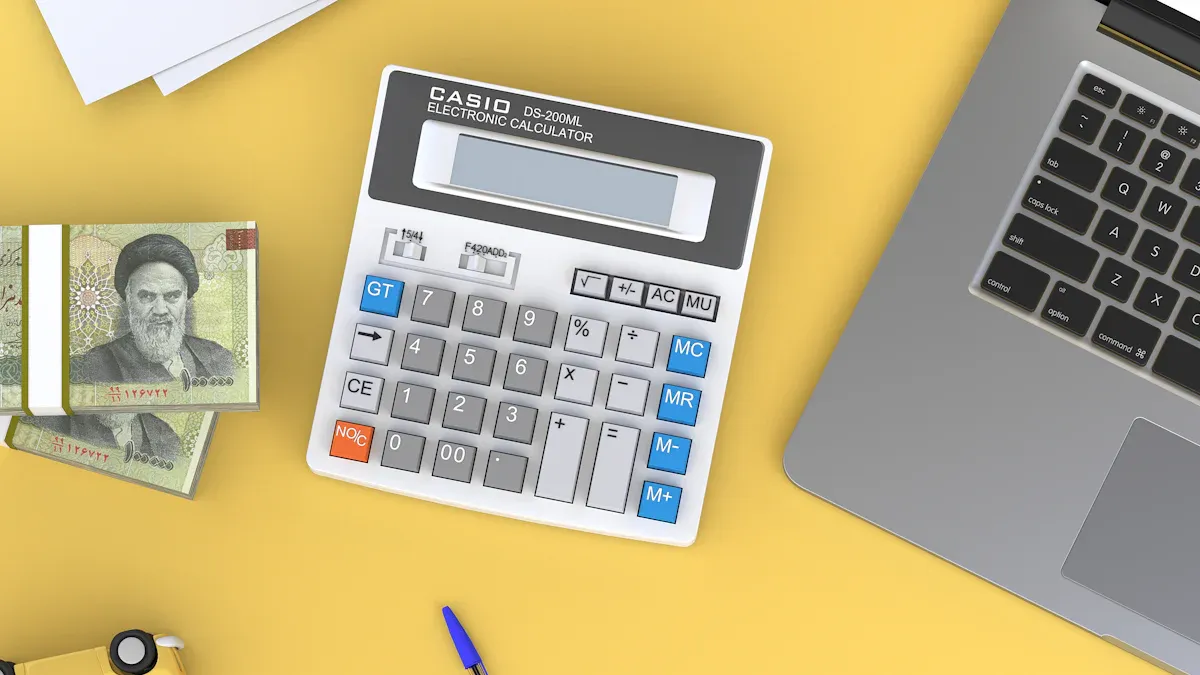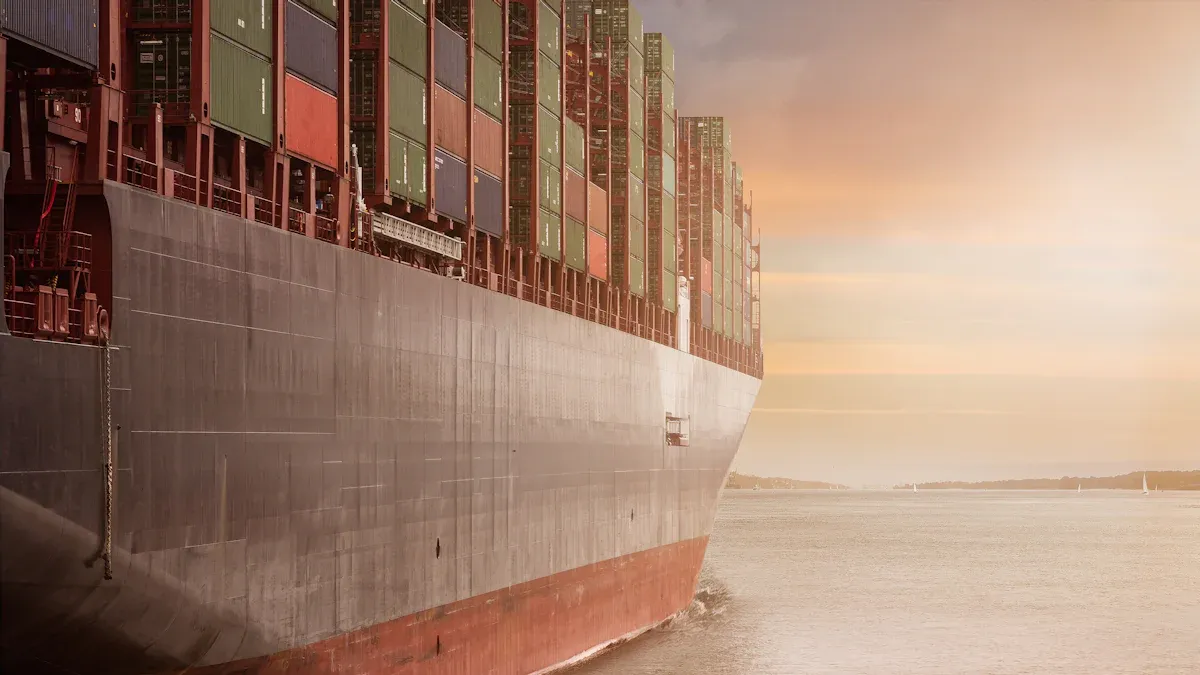You need to decide between air and sea freight for your acrylic displays. For small orders under 150 kg, air freight is often your cheaper and faster choice. Larger, heavier shipments over 150 kg make sea freight the more economical option. This guide helps you find the exact price for your order. You can use our total landed cost calculator to find all "hidden fees."
This process reveals every cost beyond the initial shipping quote. You can create a budget with confidence and avoid surprises.
Using a total landed cost calculator

You can find the true cost of your displays with a simple calculation. This calculation helps you see every expense before you commit to an order. It moves you beyond the supplier's price and the shipper's quote. You will gain a complete financial picture.
The core cost formula
The first step is understanding the basic formula. This formula adds up all the costs to get your product from the factory to your front door. It ensures you account for every dollar spent.
The core formula is:
Total Landed Cost = (Supplier Cost) + (Shipping Cost) + (Customs & Duties) + (Local Handling & Delivery Fees)
This calculation gives you the total expense. You can then divide this total by the number of displays you ordered. This gives you the final cost per unit, which is essential for setting your prices and managing your budget.
The four key components
Your total landed cost is made up of four main parts. You must account for each one to get an accurate number. Many businesses make mistakes by only considering the first two items. This leads to surprise fees and lower profits.
Here are the four components you need to track:
Product Cost: This is the price you pay your supplier for the acrylic displays. This cost is often based on the agreed-upon Incoterms, like Free on Board (FOB), which defines who pays for what part of the shipping journey.
Shipping & Freight: This covers the transportation of your goods. It includes the main air or sea freight charge, fuel surcharges, and insurance to protect your order during transit.
Customs & Duties: These are fees your government charges to import goods. The amount depends on the product's value, its material, and its Harmonized System (HS) code.
Local & Port Charges: These are the "last mile" costs. They include fees at the destination port or airport, customs brokerage fees for handling paperwork, and the final trucking cost to deliver the displays to your warehouse or home.
Common Mistakes to Avoid Calculating your landed cost seems simple, but small errors can cause big problems. Avoid these common mistakes:
Forgetting Fees: Many people overlook smaller charges like brokerage fees, bond fees, and disbursement fees. These can add up quickly.
Incorrect Codes: Using the wrong HS code for your product can lead to incorrect duty calculations and delays.
Manual Errors: Calculating everything by hand increases the chance of mistakes. An error can hurt your profit margins or make your products too expensive for customers.
To simplify this process, you can use an online total landed cost calculator. Many shipping companies offer free tools. FedEx and Freightos provide calculators that help you estimate shipping rates, duties, and taxes. Other services, like Shipping Solutions, let you compare costs from different countries.
An interactive total landed cost calculator on a website can provide instant quotes. You would enter your order details:
Product Cost
Number of Units
Carton Dimensions & Weight
Shipping Method (Air or Sea)
The tool then gives you an estimated Total Landed Cost and your final Cost Per Unit. This empowers you to make fast, informed decisions without manual guesswork.
Supplier and freight costs

The first two parts of your landed cost are the supplier payment and the shipping charges. You must understand how carriers calculate these freight costs. Air and sea freight use different methods to determine your final price.
Air freight: chargeable weight
Airlines bill you based on chargeable weight. This is the greater value between your shipment's actual weight and its volumetric weight. Volumetric weight, or dimensional weight (DIM), considers how much space your package occupies. Large, light items like acrylic displays often have a higher volumetric weight.
You can calculate the volumetric weight with a simple formula:
Volumetric Weight = (Length x Width x Height) / DIM Factor
The DIM Factor changes depending on the carrier and measurement units.
Carrier | Imperial Formula (inches/lbs) | Metric Formula (cm/kg) |
|---|---|---|
FedEx (International) | (L x W x H) / 139 | (L x W x H) / 5000 |
DHL Express (Global) | (L x W x H) / 139 | (L x W x H) / 5000 |
UPS (International) | (L x W x H) / 139 | (L x W x H) / 5000 |
Your chargeable weight will be the higher number when you compare the actual weight to this calculated volumetric weight.
Sea freight: CBM calculation
Sea freight costs for Less than Container Load (LCL) shipments depend on volume. This volume is measured in cubic meters (CBM). You calculate CBM by multiplying the dimensions of your cargo.
CBM = Length (m) x Width (m) x Height (m)
Shipping lines also have a weight-to-volume ratio. A common rule is 1 CBM = 1000 kg. Your freight cost will be based on whichever is higher: the actual CBM or the weight in metric tons. This is often called the "Weight or Measure" (W/M) rule.
Getting accurate quotes
You need to provide detailed information to get an accurate shipping quote. Incomplete details can lead to surprise fees.
Information for Your Freight Forwarder 📝
Product Details: Name, quantity, weight, and dimensions.
Packaging: How the displays are packed (cartons, pallets).
Locations: The supplier's address (origin) and your final delivery address (destination).
Dates: When the cargo is ready and when you need it delivered.
Incoterms: The trade terms agreed upon with your supplier (e.g., FOB).
You can use online freight marketplaces like Freightos or SeaRates. These platforms let you compare instant quotes from multiple carriers, helping you find the best price for your shipment.
Customs, duties, and taxes
After you calculate freight charges, you must account for government fees. These fees include customs duties and other import taxes. They are a mandatory part of your total landed cost and can significantly impact your final price per display.
Finding your HS code
You need to find the correct Harmonized System (HS) code for your acrylic displays. This universal code tells customs officers worldwide what you are importing. The code determines your duty rate and ensures your shipment is processed correctly. For acrylic displays imported into the U.S., the Harmonized Tariff Schedule (HTS) code is often 3926.90.9990.
You can verify this code using several methods:
Text Search: Use a product description like "acrylic display stand" on a government website like the US Census Bureau's search engine.
HS Code Search: Input the first 6 digits of the code (
3926.90) to see the category. The first six digits are the same globally.Expert Assistance: Ask your customs broker to confirm the correct classification for you.
Calculating customs duties
Once you have the correct HS code, you can find the duty rate. You use this percentage to calculate the duty you owe. The calculation is based on the total value of your goods plus the cost of shipping and insurance.
The formula for calculating your duty payable is straightforward. It ensures you apply the tax to the complete value of your imported goods as they arrive in the country.
You can calculate the duty with this formula:
Duty Payable = Duty Rate % x (Product Cost + Shipping Cost)
For example, if your duty rate is 5% and your product and shipping costs total $4,000, your duty payable would be $200.
Understanding import fees
Duties are not the only government charges you will face. You must also pay import processing fees. The most common one in the U.S. is the Merchandise Processing Fee (MPF).
The MPF covers the cost for Customs and Border Protection (CBP) to process your import entry.
For formal entries (shipments valued over $2,500), the MPF is 0.3464% of the product's value.
For informal entries (under $2,500), it is a small flat fee.
The MPF for formal entries has a minimum and maximum amount, which changes periodically.
Fee Type | Minimum Charge | Maximum Charge |
|---|---|---|
Formal Entry MPF | $614.35 |
If you use sea freight, you will also pay a Harbor Maintenance Fee (HMF). This fee is 0.125% of the cargo's value and helps maintain U.S. ports.
Last-mile and local handling fees
Your displays have arrived in the country, but they are not at your door yet. The final part of your landed cost covers the "last mile." These are the local handling and delivery fees that get your shipment from the port or airport to your final destination.
Terminal handling charges
When your shipment arrives, the destination terminal charges fees for unloading and handling it. These are called Terminal Handling Charges (THC). The costs differ greatly between air and sea freight. Air freight handling is simpler and less expensive. Sea freight involves more complex fees.
Air Freight Terminal Handling | Sea Freight Terminal Handling | |
|---|---|---|
Primary Charge | A single destination handling fee | Multiple fees for origin and destination handling, chassis rental, pier pass, and documentation |
Cost Range | $35–$100 per shipment | Varies widely with many minimum charges |
Complexity | Simpler and more direct | More extensive and complex |
For small sea shipments, these numerous minimum fees can add up. They can sometimes make the total cost of sea freight similar to air freight.
Customs brokerage fees
You need a customs broker to handle the import paperwork for you. Their job is to prepare and submit documents to customs authorities. This ensures your shipment clears customs without delays. The broker charges a fee for this service.
A standard brokerage fee often includes:
Entry Preparation: A fee for preparing the customs entry, usually between $50 and $150.
Disbursement Fees: A small charge for paying duties and taxes on your behalf.
Bond Fees: A fee for the customs bond required for your import.
Your broker provides expertise and manages communication with the government, which saves you time and prevents costly errors.
Inland delivery to your door
The final step is trucking your displays from the terminal to your warehouse or home. The cost of this inland delivery depends on several factors:
Distance: The farther you are from the port or airport, the higher the cost.
Cargo Size: Heavier or larger shipments require bigger trucks and more resources.
Location: Delivering to a remote or hard-to-reach area costs more.
You may also face extra charges, known as accessorials, for special services. 🚚
Watch for Extra Delivery Fees If your delivery location does not have a loading dock, you will need a truck with a liftgate. This service can cost between $75 and $150. Deliveries to a residential address also have an extra fee because it is more difficult for large trucks to navigate residential streets.
You now know that shipment size and weight determine your best freight option. Remember, landed cost can be up to 40% of your total expense. You must calculate the complete price per display.
Always use a total landed cost calculator. Do not rely only on a shipping quote. Hidden fees like customs and local handling can erase your profits.
Use the steps in this guide to compare your options with confidence. A reliable total landed cost calculator helps you avoid manual errors and make the most profitable choice for your business. 📈
FAQ
What are Incoterms?
Incoterms are rules that define your responsibilities and your supplier's responsibilities during shipping. For example, Free on Board (FOB) means the supplier pays to get the goods to the port. You pay for the main shipping, customs, and final delivery from that point.
How do I choose a freight forwarder?
You can compare quotes from different forwarders on online platforms. Look for companies with good reviews and experience shipping your type of product. Ask them if their quote includes all potential fees to avoid surprises. A good forwarder helps you save money and time.
What if my final cost is higher than the quote?
Sometimes, unexpected fees occur. You should review your final invoice carefully. Look for charges like storage fees or special delivery services. Contact your freight forwarder immediately to understand any costs you did not approve. This helps you manage your budget better next time.
Can I handle customs clearance myself?
You can handle your own customs paperwork, but it is very risky. Using the wrong code or making a mistake can lead to fines and long delays. A customs broker manages this process for you. Their fee is a small price for ensuring your shipment clears smoothly.

